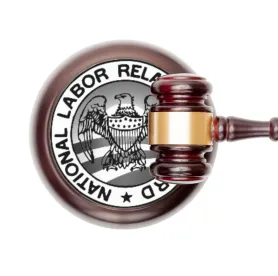It is an unfair labor practice for an employer to retaliate against (1) union supporters pursuant to Section 8(a)(3) of the National Labor Relations Act (the “Act”), and (2) employees for filing a complaint with the National Labor Relations Board, testifying in a Board proceeding, or otherwise utilizing the Board’s processes, under Section 8(a)(4). Both require an analysis of the employer’s motivation. But, does an employer violate both sections of the Act under the same factual pattern?
According to the Board, not necessarily. On February 19, 2021, the Board, in BS&B Safety Systems, LLC, 370 NLRB No. 90 (2021), held that an employer violated Section 8(a)(3) of the Act by discharging an employee for engaging in union activities, but found that the employer did not violate Section 8(a)(4), even though the employee participated and cooperated in Board proceedings over a previously-filed unfair labor practice charge.
As to the allegation of whether the employer committed unlawful discrimination, the Board affirmed the ALJ’s finding of a Section 8(a)(3) violation based almost entirely on the timing of the discharge – i.e., that the employee was discharged shortly after engaging in protected activity. With respect to the allegation of retaliation, the Board reasoned the General Counsel failed to meet its initial burden of showing that animus against the employee based on his utilization of the Board’s processes, as opposed to his union activities, was a motivating factor in the decision to terminate him. Key to the holding was the reaffirmance that an unfair labor practice sounding in retaliation based on the motive of Board participation cannot be extrapolated from the evidence supporting an unfair labor practice of retaliation based union support, generally. In short, the two motives cannot be mixed.
Background
The employer manufactures pressure relief devices that are used in military and non-military applications in addition to packaging and shipping the finished products to customers. The Union filed unfair labor practice charges against the Employer, alleging that the Employer violated Sections 8(a)(3) and (4) of the Act, by terminating an employee, who was the local union president. As the local union president, the employee was an active union supporter and vocal proponent of the union’s collective bargaining demands during a heated collective bargaining negotiation – e.g., the employee coordinated activities among the bargaining unit members, such as putting stickers on their personal belongings and cars, saying “Fair Contract Now.”
The parties had entered into a board settlement regarding prior allegations by the Union against the Employer, alleging the Employer had engaged in union animus. The local president was involved in prosecuting the original unfair labor practice charge and participated in resolving the matter. One of the disputed issues between the parties was the number of employees the employer allowed to take vacation at one time without bargaining with the union. Even after the settlement, the vacation issue persisted between the parties. The local president emailed the Employer regarding the vacation issues and added, “Kicking the can down the road is lazy management & does not address anything.” Just three hours later, the local president was suspended for an alleged production error that allegedly occurred about two and a half weeks before.
In response to the charge, the Employer argued it would have discharged the employee because he committed “an historically severe production error” that warranted termination – regardless of his union activity. The ALJ and Board disagreed, concluding that the employer did not sufficiently explain why it permitted other employees to rework significant production errors in the past nor why this employee’s mistakes were more severe than the errors of employees whom it did not discipline at all. The ALJ and Board found the Employer’s argument was a pretext since other employees had not been discharged for similar errors.
Analysis: The Same Burden Shifting Test is Used for analyzing 8(a)(3) and 8(a)(4)Allegations
As noted above, the ALJ found that the Employer violated Sections 8(a)(3) and (4) of the Act by terminating the local union president. On appeal, the Board reversed the ALJ on the Section 8(a)(4) violation and dismissed the allegation.
The Section 8(a)(3) violation was found based on the timing of the discharge, shifting reasons for the termination, and pretext suggesting union animus was the real motive for discharge. It is instructive that the Board found the General Counsel met his initial burden largely on the timing of the discharge alone, finding that the employee engaged in union activity in his role as local union president, including continuously contacting the Employer regarding vacation issues, and that the Employer was indisputably aware of his union activity. Shortly after the employee wrote a message that management was “lazy,” he was discharged. The Board concluded that because the Employer failed to conduct a meaningful investigation of the employee’s production error and disparately treated him by firing him for this conduct, when the Employer has not always terminated employees for similar errors, constituted pretext.
As to the Section 8(a)(4) charge, the Board found the General Counsel failed to meet his burden of establishing a prima facie case – again, based primarily on the timing of the discharge and the local president’s activity. While the employee was a named discriminatee in the prior Board charge, attended the hearing as a subpoenaed witness, and communicated with the Employer about the settlement, the Board settlement was entered into six months prior to the employee’s termination, and there was not a close nexus between the employee’s utilization of the Board’s processes and the adverse employment action. The Board refused to conflate the protected activity motives and extrapolate from that evidence, that the employee’s participation in Board activity many months before was a motivating factor in his termination.
Takeaways
This decision reaffirms the long-standing principle that both 8(a)(3) and (4) unfair labor practices utilize the Wright Line burden shifting test, which requires the NLRB General Counsel to make a prima facie showing that discriminatory animus was present in the motivation for the adverse action. If the General Counsel meets this burden, the test requires the Employer to rebut the claim by demonstrating a legitimate business justification. While the same adverse employment action, such as termination, could form the basis of both an 8(a)(3) and (4) charge, the Board’s holding importantly cautions against conflating the mixed motives for the same conduct. In other words, the General Counsel must meet his burden under Wright Line by showing a clear nexus between the adverse employment action and the discriminatory animus for union support (to establish a 8(a)(3) violation) and for utilizing the Board’s processes (to succeed on a 8(a)(4) claim).
Employers should be aware that the timing between the adverse employment action and the underlying conduct allegedly giving rise to the employment action will be an important consideration in the ALJ and Board’s analysis. Indeed, in many cases, timing will be dispositive on the outcome.
We have said this many times, but this is a decision that easily could have come out differently with a finding of a violation as to both allegations. The Board in this case closely examined the requirements for each allegation and made a conclusion. While there may be little material difference between one or two violations for the same event, for those employers defending such allegations, this shows how a separate legal analysis should be rendered for each separate allegation.




 />i
/>i

